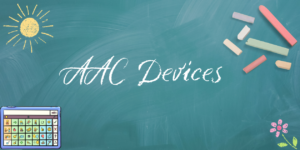
AAC methods that don’t use advanced computer technology include signing, gestures, written words, symbols and picture books. Specific products available in this category, include symbol charts, large pictures or objects of reference.
AAC methods that employ the use of technology do so at varying levels of complexity. The majority of them focus on producing speech or text for a user who finds it difficult or impossible to produce this themselves. Some take the symbol systems mentioned above and turn them into computerised versions which speak aloud the symbols selected.
For people who have additional needs that make it difficult for them to use a keyboard or touchscreen, computerised AAC devices can be operated in different ways, such as via switch or eye gaze technology. The latter relies on a user’s eyes to navigate the screen and operate the system. AAC technology is also available on smaller, mobile devices.
As a communication aid, an AAC device will be used constantly so it must be chosen and tailored to the user to ensure it is the right one for them.
An AAC specialist or speech and language therapy department may be able to help assess which kind of AAC device may be of the most use.
You can read more about AAC products on the Communication Matters website.

